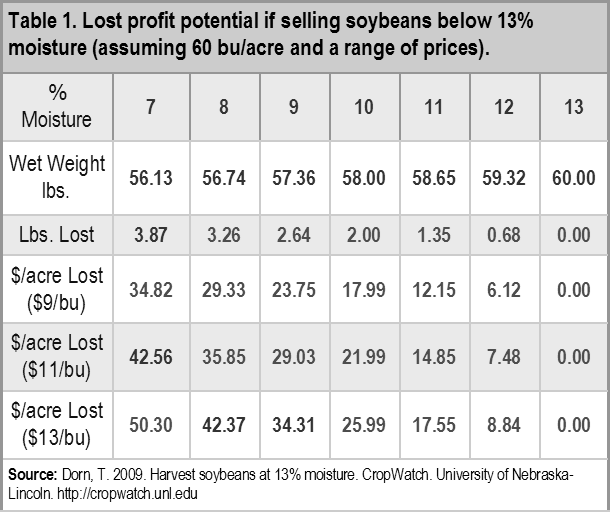Monitor Soybean Moisture
As soybeans begin to dry down, growers should monitor crop moisture levels and prioritize soybean field harvest order. Soybeans with moisture content at or below 13% moisture are the most profitable for growers when delivered to the elevator.
Soybeans delivered at a moisture content above 13% can be docked by the elevator. Soybeans testing under 13% moisture may be accepted by the buyer; however, the grower will lose profit potential for the reduced moisture content. For example, a standard 60 pound bushel contains 87% dry matter and 13% moisture, or 52.2 lbs. dry matter and 7.8 lbs. moisture. If the moisture content drops to 11%, the dry matter weight per bushel increases to 89% or 58.65 lbs. For every 52.2 lbs. of dry matter sold at 11% moisture, the seller loses an opportunity to sell 1.35 lbs. of water.
Lost Profit Potential
Table 1 shows an example the lost profit potential when growers deliver soybeans at moisture levels below 13% (assuming a 60 bu/acre yield and $13/bu). To convert the dollars per acre loss to other yields, divide the expected yield by 60. Then multiply the result by the $/acre lost. For example, to convert to an expected yield of 45 bu/acre, divide 45 by 60 (45/60 = 0.75). At $13/bu, soybeans yielding 45 bu/acre and delivered at 11% moisture would suffer a profit potential loss of $8.61/acre ($11.48 x 0.75 = $8.61).
To adjust Table 1 for different grain prices, divide the expected price by $13. For example, to convert from $13/bu to $9/bu divide $9 by $13 (9/13 = 0.69). To determine the profit potential loss for $9/bu soybeans at 11% moisture, multiply $17.55 by 0.69 ($17.55 x 0.69 = $12.15).

Harvest Decisions
Harvest should begin as soon as the crop reaches a moisture content of 14 to 15%, to help maximize grain weight and minimize yield losses. Soybeans should reach 15% moisture content about 5 to 10 days after 95% of the pods have reached their mature color under good drying conditions. If drying equipment is available, harvest can start at 17 to 18% moisture content. Harvesting as much of the crop as possible before the moisture level drops below 12% will help to reduce splits and cracked seed coats. When mature soybeans undergo multiple wetting and drying cycles, the grain can lose test weight and quality.
When faced with both dry and green soybeans in the same field, growers should consider harvesting at two different times. Time and equipment constraints can make it necessary to harvest the whole field at once. In that case, growers should be aware of field conditions throughout so they make the best harvest-timing decision for the majority of the field.
Adjust Harvest Equipment
More than 75% of soybean harvest losses can be attributed to the gathering unit. While some grain loss is expected during harvest, mechanical losses can be kept to a minimum with proper equipment maintenance and operation. Some important points to remember include:
- Ground speed should be reduced to 5 miles/hour or less.
- Cutter bar should be operated as close to the ground as possible.
- Knife sections should be sharp, and guards, wear plates and hold-down clips should be in good condition and properly adjusted.
- Reel speed should be about 25% faster than ground speed.
- The cylinder should be operated at the slowest speed that will allow complete threshing.
- To maintain moisture and reduce shattering losses, growers should avoid harvesting when soybeans are the driest, such as on hot afternoons.

Grain Storage
Soybeans kept at 13% moisture content, and at temperatures below 60°F, can be stored for at least six months. However, during warmer spring and summer months, moisture content should be reduced to 11%. Foreign materials and fines should be removed with an air screen cleaner to allow more even air flow during drying.
Sources:
Conley, S. 2017. Harvest considerations for variable soybean maturity. Integrated Pest and Crop Management. University of Wisconsin. http://ipcm.wisc.edu/; Dunphy, J., and Beasley, E.O. 2017. Reduce soybean harvest losses. North Carolina State University. http://ipm.ncsu.edu/; Dorn, T. 2009. Harvest soybeans at 13% moisture. CropWatch. University of Nebraska-Lincoln. http://cropwatch.unl.edu; Soybean harvest not the time to play the waiting game. 2005. AgAnswers. Ohio State Extension and Purdue Extension; Soybean production field guide for ND and NWMN. 2010. North Dakota State University Extension. www.ag.ndsu.edu/. Web sources verified 8/28/2018.
